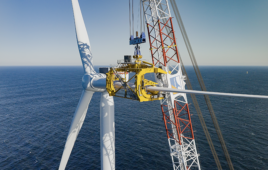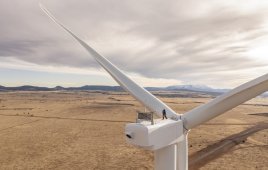
Seals, indicated in black, are used on a variety of bearings in a nacelle. Improving seal function improves the reliability and efficiency of the turbine.
In July 2008, the Energy Efficiency and Renewable Energy Department of the U.S. Department of Energy published a document 20% Wind Energy by 2030 that included wind-energy volume projections. The projections were based on many factors and assumptions, including justification of capital, improvement of wind-turbine efficiencies, lower annual maintenance costs, and reliable component life.
Increasing component reliability to achieve 20% wind energy will require advancements in component design, materials, and testing methods to validate wind-turbine components in the harshest environments. No component should be overlooked in the quest to increase energy captured by wind turbines. For example, if the seal for a blade pitch bearing—which many consider a commodity—is unreliable, designed improperly, or made with poor material, it will leak grease and eventually prevent the blades from pitching. The whole turbine will under-perform. Hence, small components can have a big impact when not properly designed or tested.
Slewing-bearing seals should also keep grease in and detrimental environmental elements (dirt, salt, water, sand) out of the bearing’s working elements. This sounds simple, but many factors contribute to the proper function and reliability of the seal. As OEMs build larger wind turbines and expand into new regions of the world, some factors will change to influence life expectancy and reliability of slewing-bearing seals. Thus, seal suppliers require close cooperation with those bearing companies, grease suppliers, and M&O groups to ensure the proper evaluation and evolution of these components.
Realizing that a single component cannot drive the 20% energy goal alone, it is vital to recognize and appreciate how each turbine

The seal cross section illustrates the complexity to which Simrit can design. Bearings in each turbine model can differ from each other and would require different seal cross sections. Seals for any diameter bearing are extruded, cut to length, and bonded.
component plays an important role in making the turbine industry successful. As a result, many companies continue to invest in new materials and designs. Two recent material examples are Ventoguard 453 and 454, formulated for ozone resistance and reduced compression set, as well as newly improved seal geometries that keep grease where it belongs, increases seal life, and improves turbine service.
In addition to design and material innovations, new technologies are being developed to address industry-related challenges. One example is a way to reduce seal friction that can influence the motor size needed to pitch a turbine blade. Larger wind turbines require large slewing bearings (over a meter in diameter) hence large diameter seals. Reducing the friction between bearing and seal helps decrease pitch-motor size. Smaller motors mean a lower-cost machine to rotate the blade and—to some extent— less tower weight.
Growing the wind industry market to 20% in North America will require continuous collaboration and experimentation to increase the reliability of wind-turbine components. Improved material properties and seal geometry of slewing-bearing seals is just one way to increase turbine life and reduce overall project costs. WPE
Filed Under: Components, Seals & slip rings





